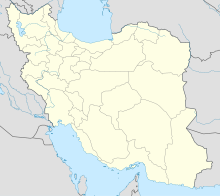Jiroft culture
Coordinates: 28 ° 30 ′ 0 ″ N , 57 ° 48 ′ 0 ″ E
The Dschiroft culture (also Jiroft civilization ) was a Near Eastern archaeological culture of the Bronze Age of the late 3rd millennium BC. Postulated. The area of this culture is in the Iranian provinces of Sistan and Kerman . The hypothesis is based on a collection of artifacts that have been confiscated in Iran and most likely originate from the Jiroft region.
The suggested site is Konar Sandal near Jiroft in the Halil River area . Other important sites associated with this culture are Schahr-e Suchte , Tepe Bampur , Espiededsch , Schahdad , Iblis and Tepe Yahya .
Yousef Majidzadeh , head of the archaeological excavation team in Jiroft, suggested grouping the aforementioned sites into an "independent Bronze Age civilization with its own architecture and language". He sees their distribution area between the ancient Elam in the west and the Indus culture in the east. He also speculates that it is a holdover from the lost Aratta kingdom. His conclusions met with the skepticism of some critics. Other assumptions (e.g. those of Daniel T. Potts and Piotr Steinkellers ) see a connection between Konar Sandal and the obscure city-state of Marhasi , which is said to be in the east of today's Elam .
Discovery and excavation
Many artifacts associated with Jiroft were rediscovered by “robbers”, described as “villagers in need”, who roamed the area before Yousef Majidzadeh and his team began digging in 2001. The team examined an area of more than 2 km² and uncovered the remains of a city that dates back to the late 3rd millennium BC. Dated.
The stolen artifacts and some of the vessels rediscovered by the excavators are ceramics in the so-called "intercultural style" known from Mesopotamia and the Iranian plateau and, since 1960, from the vicinity of Tepe Yahya in Baft. The thesis of the “Jiroft civilization” suggests that this “intercultural style” is in truth the unmistakable style of a previously unknown, long-lived civilization.
Not all scientists accept this claim. The archaeologist Oscar Muscarella from the Metropolitan Museum of Art criticizes that the excavator fled into sensational reports because he was taking longer and longer to publish scientific papers, and that he apologized that the stratigraphy of the site had a continuity into the 4th Millennium BC BC show what Muscarella thinks is overly optimistic. But the importance of the site is also confirmed by Muscarella.
Earlier excavations at Kerman were carried out by Sir Aurel Stein in 1930 .
One of the most notable excavations in Kerman Province was carried out by a group from the Illinois State Museum led by Professor Joseph Caldwell at Tal-i Iblis in 1966, and another noteworthy in 1967 by Lamberg-Karlovsky of Harvard University at Tepe Yahya in the Sogan Valley , Dolatabad .
Archaeological excavations in Jiroft also led to the discovery of various objects that date back to the 4th millennium BC. Belong to.
According to Majidzadeh and geophysical studies by French experts, at least ten historical and archaeological periods belonging to different civilizations can be detected in the region. According to the French, traces of these civilizations can be detected up to 11 m below the surface.
The Dschiroft site
The main site is located about 25 km from Jiroft and consists of two hills, called Konar Sandal A and B, with heights of 13 and 21 m respectively. A two-story citadel with a base of nearly 13.5 hectares was found in Sandal B.
Alleged writing system
Madjidzadeh claims to have discovered inscriptions in a previously unknown manuscript that are supposedly comparable to the Elamite linear script and date back to the 22nd century BC. To date. The announcement of this discovery was received with skepticism. Andrew Lawler cites Jacob Dahl , a specialist in ancient texts at the Free University of Berlin , who said: "No specialist in the world would consider this, it is nothing but a forgery."
Piotr Steinkeller , a professor of Assyriology in the Department of Languages and Civilizations of the Middle East at Harvard University, said that "the inscription discovered in Jiroft has no relation to Elamite manuscripts and belongs to the Eastern civilizations."
literature
- Jiroft. Fabuleuse découverte en Iran (= Dossiers d'Archéologie. No. 287, ISSN 1141-7137 ). Faton, Dijon 2003.
- Andrew Lawler: Ancient Writing or Modern Fakery? In: Science . Vol. 317, No. 5838, August 3, 2007, pp. 588-589, doi : 10.1126 / science.317.5838.588 .
- Andrew Lawler: Iranian Dig Opens Window on New Civilization. In: Science. Vol. 304, No. 5674, 21 May 2004, pp. 1096-1097, doi : 10.1126 / science.304.5674.1096b .
- Yousef Majidzadeh: Jiroft. The earliest oriental civilization. Organization of the Ministry of Culture ans Islamic Guidance, Tehran 2003, ISBN 964-422-478-7 .
- Maḥmūd Riḍā Māhirī: تمدّن های نخستین کرمان = The Early Civilizations Of Kerman. Markaz-i Kirmānšināsī, Kirmān 1379 h.š. (2000/2001), ISBN 964-6487-21-1 .
- Oscar White Muscarella : Jiroft and "Jiroft-Aratta": A Review Article of Yousef Madjidzadeh, Jiroft: The Earliest Oriental Civilization. In: Bulletin of the Asia Institute. Vol. 15, 2005, ISSN 0890-4464 , pp. 173-198, online (PDF; 480 KB) .
Web links
- Jiroft culture . In: Ehsan Yarshater (Ed.): Encyclopædia Iranica (English, including references)
- Jiroft civilization
- jiroft..htm saudiaramcoworld.com: What Was Jiroft? ( پایگاه خبری جیرفت / issue / 200405 / Jiroft. Artifacts / popup_content.html image gallery )
- morenews.ir: "New studies show Jiroft was ancient trade link"
- chnpress.com: Jiroft Inscription, Oldest Evidence of Written Language
- chnpress.com: New Discoveries in Jiroft May Change History of Civilization
- chnpress.com: Jiroft was an international trade center 5000 years ago


